 W
WUrban decay is the sociological process by which a previously functioning city, or part of a city, falls into disrepair and decrepitude. It may feature deindustrialization, depopulation or deurbanization, economic restructuring, abandoned buildings and infrastructure, high local unemployment, increased poverty, fragmented families, low overall living standards and quality of life, political disenfranchisement, crime, elevated levels of pollution, and a desolate cityscape, known as greyfield or urban prairie. Since the 1970s and 1980s, urban decay has been associated with Western cities, especially in North America and parts of Europe. Since then, major structural changes in global economies, transportation, and government policy created the economic and then the social conditions resulting in urban decay.
 W
WAn abandoned graveyard is a burial ground that has ceased to operate because the county assessor is unable to determine ownership, or because the organization established for the burial of deceased persons has been diffused or departmentally terminated by the secretary of state, or for some other reason where ownership has not been transferred, or because the graveyard no longer has a valid certificate of authority to operate as determined by the board of graveyard and funeral commissioners. Simply put, a cemetery that has ceased to be taken care of by officials and no longer recognized officially as a cemetery.
 W
WThe broken windows theory is a criminological theory that states that visible signs of crime, anti-social behavior, and civil disorder create an urban environment that encourages further crime and disorder, including serious crimes. The theory suggests that policing methods that target minor crimes, such as vandalism, loitering, public drinking, jaywalking and fare evasion, help to create an atmosphere of order and lawfulness.
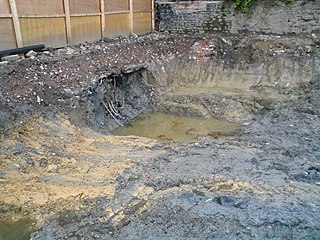 W
WIn urban planning, brownfield land is any previously developed land that is not currently in use that may be potentially contaminated. The term is also used to describe land previously used for industrial or commercial purposes with known or suspected pollution including soil contamination due to hazardous waste.
 W
WA council garden estate is a housing estate planned and built for the rehousing of people from decaying inner city areas, pioneered by Ted Hollamby at Cressingham Gardens, Lambeth, in the 1960s. It was a reaction to the philosophy of Ernő Goldfinger, Lubetkin and Le Corbusier who saw a housing estate as an architectural monument. Hollamby sought an anti- monumental architecture, to design for the wishes and needs of the people. High density was achieved by pedestrianising the estate and having external car-parking
 W
WA drug house is a residence used in the illegal drug trade. Drug houses shelter drug users and provide a place for drug dealers to supply them. Drug houses can also be used as laboratories to synthesize (cook) drugs, or cache ingredients and product.
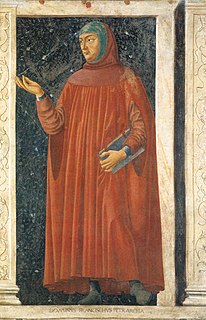 W
WThe "Dark Ages" is a term for the Early Middle Ages or Middle Ages in the area of the Roman Empire in Europe, after its fall in the fifth century, characterizing it as marked by economic, intellectual and cultural decline.
 W
WA dead mall is a shopping mall with a high vacancy rate or a low consumer traffic level, or that is deteriorating in some manner.
 W
WDeadmalls.com is an independent not-for-profit website best known for featuring shopping malls in the United States that have failed or are in the process of failing. The site features nearly 450 listings of dead or dying shopping malls, many with pictures and historical narratives.
 W
WDe-industrialization is a process of social and economic change caused by the removal or reduction of industrial capacity or activity in a country or region, especially of heavy industry or manufacturing industry.
 W
WEastmont Town Center is a shopping mall and social services hub located on 33 acres (130,000 m2) bounded by Foothill Boulevard, Bancroft Avenue, 73rd Avenue, and Church Street, in the Frick neighborhood of East Oakland. The mall opened in 1970 on the site of a 1920s-era Chevrolet automobile factory called Oakland Assembly. Architect William Pereira designed the building. It is physically almost next to, and by entry access a few blocks away from the similarly sized Evergreen Cemetery.
 W
WSince the start of the twentieth century, the role of cars has become highly important, though controversial. They are used throughout the world and has become the most popular mode of transport in many of the more developed countries. In developing countries, the effects of the car on society are not as visible, however they are nonetheless significant. The development of the car built upon the transport sector first started by railways. This has introduced sweeping changes in employment patterns, social interactions, infrastructure and the distribution of goods.
 W
WEnvironmental racism is a concept in the environmental justice movement, which developed in the United States throughout the 1970s and 1980s. The term is used to describe environmental injustice that occurs within a racialized context both in practice and policy. In the United States, environmental racism criticizes inequalities between urban and exurban areas after white flight. Internationally, environmental racism can refer to the effects of the global waste trade, like the negative health impact of the export of electronic waste to China from developed countries.
 W
WUrban exploration is the exploration of manmade structures, usually abandoned ruins or hidden components of the manmade environment. Photography and historical interest/documentation are heavily featured in the hobby and it sometimes involves trespassing onto private property. Urban exploration is also called draining, urban spelunking, urban rock climbing, urban caving, building hacking, or mousing.
 W
WA flophouse or dosshouse is considered a derogatory term for a place that offers very low cost lodging, providing space to sleep and minimal amenities.
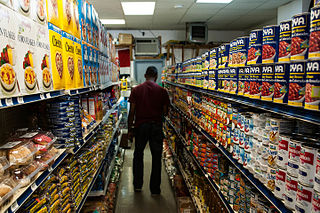 W
WA food desert is an area that has limited access to affordable and nutritious food, in contrast with an area with higher access to supermarkets or vegetable shops with fresh foods, which is called a food oasis. The designation considers the type and quality of food available to the population, in addition to the accessibility of the food through the size and proximity of the food stores.
 W
WForeclosure is a legal process in which a lender attempts to recover the balance of a loan from a borrower who has stopped making payments to the lender by forcing the sale of the asset used as the collateral for the loan.
 W
WHighway revolts are organized protests against the planning or construction of highways, freeways, expressways, and other civil engineering projects that favor vehicles.
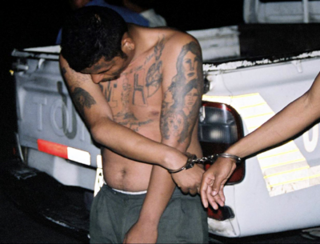 W
WReports on the number of people involved in criminal gangs, by locale.
 W
WA ghetto, often the ghetto, is a part of a city in which members of a minority group live, especially as a result of social, legal, or economic pressure. Ghettos are often known for being more impoverished than other areas of the city. Versions of the ghetto appear across the world, each with their own names, classifications, and groupings of people.
 W
WA ghost town or alternatively deserted city or abandoned city is an abandoned village, town, or city, usually one that contains substantial visible remaining buildings and infrastructure such as roads. A town often becomes a ghost town because the economic activity that supported it has failed, or due to natural or human-caused disasters such as floods, prolonged droughts, extreme heat or extreme cold, government actions, uncontrolled lawlessness, war, pollution, or nuclear disasters. The term can sometimes refer to cities, towns, and neighbourhoods that are still populated, but significantly less so than in past years; for example, those affected by high levels of unemployment and dereliction.
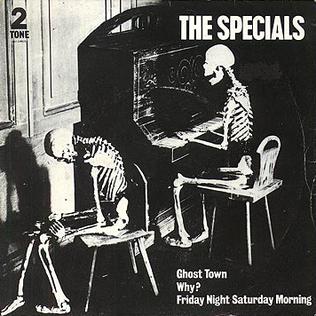 W
W"Ghost Town" is a song by the British two-tone band the Specials, released on 12 June 1981. The song spent three weeks at number one and 10 weeks in total in the top 40 of the UK Singles Chart. Addressing themes of urban decay, deindustrialisation, unemployment and violence in inner cities, the song is remembered for being a hit at the same time as riots were occurring in British cities. Internal tensions within the band were also coming to a head when the single was being recorded, resulting in the song being the last single recorded by the original seven members of the group before splitting up. However, the song was hailed by the contemporary UK music press as a major piece of popular social commentary, and all three of the major UK music magazines of the time awarded "Ghost Town" the accolade of "Single of the Year" for 1981.
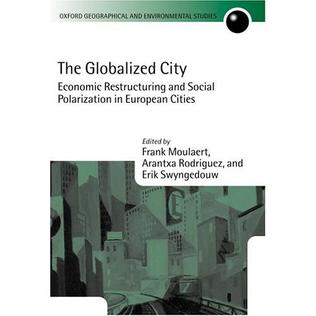 W
WThe Globalized City: Economic Restructing and Social Polarization in European Cities is a collection of discussions and case studies of large-scale urban development projects in nine European cities. It analyzes the relation between these projects and trends such as social exclusion, the emergence of new urban elites, and the consolidation of less democratic forms of urban governance.
 W
WGreenfield land is a British English term referring to undeveloped land in an urban or rural area either used for agriculture or landscape design, or left to evolve naturally. These areas of land are usually agricultural or amenity properties being considered for urban development.
 W
WGreyfield land is economically obsolescent, outdated, failing, moribund, or underused real estate assets or land. The term was first used in the UK in Urban Design theory in the late 1990's, and coined in the US in the early 2000's the name coming from the "sea" of empty asphalt concrete that often accompanies these sites. The word greyfield, also greyfields, is a relative neologism as compared to more commonly known terms such as brownfield and greenfield.
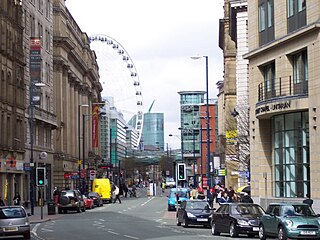 W
WThe term inner city has been used, especially in the United States, as a euphemism for lower-income residential districts that often refer to run down neighbourhoods, in a downtown or city centre area. Sociologists sometimes turn the euphemism into a formal designation by applying the term inner city to such residential areas, rather than to more geographically central commercial districts.
 W
WLife After People is a television series on which scientists, mechanical engineers, and other experts speculate about what might become of Earth if humanity suddenly disappeared. The featured experts also talk about the impact of human absence on the environment and the vestiges of civilization thus left behind. The series was preceded by a two-hour special that aired on January 21, 2008, on the History Channel which served as a de facto pilot for the series that premiered April 21, 2009. The documentary and subsequent series were both narrated by James Lurie.
 W
WModern ruins is a neologism referring to the ruins of architecture constructed in the recent past, generally in the most recent century, or since the 19th century. The term is most frequently used by people performing urban exploration of man-made architecture that is abandoned or no longer accessible to the general public, such as structures abandoned through the process of urban decay. Enough documentation on these sites may have been lost over time that this unscientific exploration resembles archaeology of ancient ruins in the methods used to collect information.
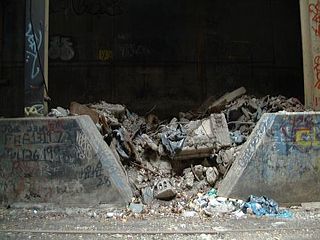 W
WMole people are homeless people living under large cities in abandoned subway, railroad, flood, sewage tunnels, and heating shafts. The term may also refer to the speculative fiction trope of an entirely subterranean society.
 W
WAn overspill estate is a housing estate planned and built for the housing of excess population in urban areas, both from the natural increase of population and often in order to rehouse people from decaying inner city areas, usually as part of the process of slum clearance. They were created on the outskirts of most large British towns and during most of the 20th century, with new towns being an alternative approach outside London after World War II. The objective of this was to bring more economic activity to these smaller communities, whilst relieving pressure on overpopulated areas of major cities. The Town Development Act 1952 encouraged the expansion of neighbouring urban areas rather than the creation of satellite communities. The authorities wished to divert people living in poor conditions within highly populous cities to better conditions on the outskirts of these cities. Overspill not only involves moving people to a new area, but requires industry and employment to follow. Often the industries and resources took longer to migrate than the people, hence there were a number of issues surrounding early overspill projects. Slum clearance tenants often had problems with the move, since it separated them from extended family and friends, needed services were often lacking, and only the better off workers could afford the extra cost of commuting back to their jobs. Another criticism was that the new estates occupied what had been productive agricultural land.
 W
WA punk house is a dwelling occupied by members of the punk subculture. Punk houses are similar to the hippie crash pads of the 1960s. The Factory, an alternative living space founded by Andy Warhol as the home base of The Velvet Underground, is directly linked to the formation of punk rock in New York City. In the early 1980s, a few punk gangs developed around allegiance to certain punk houses.
 W
WRacial segregation is the systematic separation of people into racial or other ethnic groups in daily life. Racial segregation can amount to the international crime of apartheid and a crime against humanity under the Statute of the International Criminal Court. Segregation can involve the spatial separation of the races, and mandatory use of different institutions, such as schools and hospitals by people of different races. Specifically, it may be applied to activities such as eating in restaurants, drinking from water fountains, using public toilets, attending schools, going to movies, riding buses, renting or purchasing homes or renting hotel rooms. In addition, segregation often allows close contact between members of different racial or ethnic groups in hierarchical situations, such as allowing a person of one race to work as a servant for a member of another race.
 W
WRedevelopment is any new construction on a site that has pre-existing uses. It represents a process of land development uses to revitalize the physical, economic and social fabric of urban space.
 W
WIn the United States and Canada, redlining is the systematic denial of various services to residents of specific, often racially associated, neighborhoods or communities, either explicitly or through the selective raising of prices. While the best known examples of redlining have involved denial of financial services such as banking or insurance, other services such as health care or even supermarkets have been denied to residents. In the case of retail businesses like supermarkets, purposely locating stores impractically far away from targeted residents results in a redlining effect.
 W
WResidential segregation in the United States is the physical separation of two or more groups into different neighborhoods—a form of segregation that "sorts population groups into various neighborhood contexts and shapes the living environment at the neighborhood level". While it has traditionally been associated with racial segregation, it generally refers to any kind of sorting of populations based on some criteria.
 W
WThe retail apocalypse is the closing of numerous brick-and-mortar retail stores, especially those of large chains worldwide, starting around 2010 and continuing onward. In 2019, retailers in the United States announced 9,302 store closings, a 59% jump from 2018, and the highest number since tracking the data began in 2012. Over 12,000 physical stores have closed due to factors including over-expansion of malls, rising rents, bankruptcies of leveraged buyouts, low quarterly profits outside holiday binge spending, delayed effects of the Great Recession, and changes in spending habits. American consumers have shifted their purchasing habits due to various factors, including experience-spending versus material goods and homes, casual fashion in relaxed dress codes, as well as the rise of e-commerce, mostly in the form of competition from juggernaut companies such as Amazon.com and Walmart. A 2017 Business Insider report dubbed this phenomenon the "Amazon effect," and calculated that Amazon.com was generating greater than 50% of the growth of retail sales.
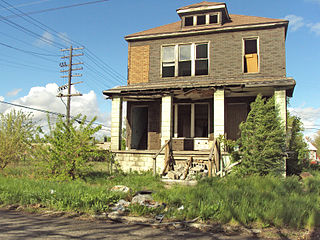 W
WShrinking cities or urban depopulation are dense cities that have experienced a notable population loss. Emigration is a common reason for city shrinkage. Since the infrastructure of such cities was built to support a larger population, its maintenance can become a serious concern. A related phenomenon is counterurbanization.
 W
WA skid row or skid road is an impoverished area, typically urban, in English-speaking North America whose inhabitants are mostly poor people "on the skids". This specifically refers to poor, homeless or other low life people, either considered disreputable, downtrodden or forgotten by society. A skid row may be anything from an impoverished urban district to a red-light district to a gathering area for homeless people and drug addicts. In general, skid row areas are inhabited or frequented by individuals marginalized by poverty and also drug addicts. Urban areas considered skid rows are marked by high vagrancy, dilapidated buildings, and drug dens, as well as other features of urban blight. Used figuratively, the phrase may indicate the state of a poor person's life.
 W
WSocial cleansing is class-based killing that consists of the elimination of members of society who are considered "undesirable," including, but not limited to, the homeless, criminals, street children, the elderly, the disabled, sex workers, and sexual minorities. This phenomenon is caused by a combination of economic and social factors, but killings are notably present in regions with high levels of poverty and disparities of wealth. Perpetrators are usually of the same community as the victims and they are often motivated by the idea that the victims are a drain on the resources of society. Efforts by national and local governments to stop these killings have been largely ineffective, and the government and police forces are often involved in the killings, especially in South America.
 W
WSocial exclusion or social marginalisation is the social disadvantage and relegation to the fringe of society. It is a term used widely in Europe and was first used in France. It is used across disciplines including education, sociology, psychology, politics and economics.
 W
WSquatting is the action of occupying an abandoned or unoccupied area of land or a building, usually residential, that the squatter does not own, rent or otherwise have lawful permission to use. The United Nations estimated in 2003 that there were one billion slum residents and squatters globally. Squatting occurs worldwide and tends to occur when people who are poor and homeless find empty buildings or land to occupy for housing. It has a long history, broken down by country below.
 W
WA squeegee man or squeegee woman, squeegee kid (Canada), squeegee boy (Baltimore), squeegee punk (Montreal), squeegee merchant (London), squeegee guy or squeegee bandit is a person who, using a washcloth and squeegee, wipes windshields of cars stopped in traffic, in exchange for money.
 W
WA storefront church is a church in the USA that is housed in a storefront building that formerly had a commercial purpose.
 W
WSuburbanization is a population shift from central urban areas into suburbs, resulting in the formation of (sub)urban sprawl. As a consequence of the movement of households and businesses out of the city centers, low-density, peripheral urban areas grow.
 W
WA transit desert is an area with limited transportation supply. Developed from the concept of food deserts various methods have been proposed to measure transit deserts. Transit deserts are generally characterized by poor public transportation options and possibly poor bike, sidewalk, or road infrastructure. The lack of transportation options present in transit deserts may have negative effects of people’s health, job prospects, and economic mobility.
 W
WUrban prairie is a term to describe vacant urban land that has reverted to green space. Previous structures occupying the urban lots have been demolished, leaving patchy areas of green space that are usually untended and unmanaged, forming an involuntary park. Sometimes, however, the prairie spaces are intentionally created to facilitate amenities, such as green belts, community gardens and wildlife reserve habitats.
 W
WThe welfare trap theory asserts that taxation and welfare systems can jointly contribute to keep people on social insurance because the withdrawal of means-tested benefits that comes with entering low-paid work causes there to be no significant increase in total income. An individual sees that the opportunity cost of returning to work is too great for too little a financial return, and this can create a perverse incentive to not work.